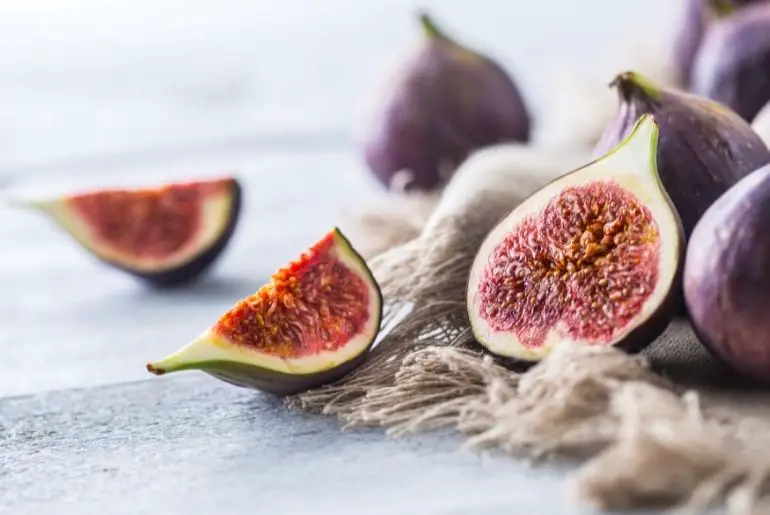Can Cats Eat Figs? (Risks & Benefits)

Well, like many other plants, a fig is safe for humans. But that’s not the case when it comes to cats. Every part of the fig plant, including the fruit, leaves, as well as sap, is toxic for cats. The toxicity level of figs may vary between low to moderate. So, if you catch your little kitty eating a fig and then notice some abnormal behavior in it, seek immediate veterinary care.
To know more about the nutrition content and the toxicity level, symptoms, and other things relating to figs and cats, continue reading the article.
Contents
Nutrition Content And Benefits Of Fig
The main content of fig fruit (100 gm) includes:
- 74 calories.
- 79% water.
- 19% carbohydrates (dietary fiber).
In addition to this, the fruit also contains moderate quantities of:
- Vitamin B6,
- Vitamin K.
- Thiamine,
- Pantothenic acid,
- Riboflavin,
- Manganese,
- Magnesium,
- Calcium,
- Potassium and many other vitamins as well as minerals.
If you dry the fruit to 30% water content, then 100 gm of fig fruit will contain around 249 calories and 64% carbohydrates.
Fig fruit is not only rich in nutrients, but it also has various essential phytochemicals polyphenols, such as:
- Syringic or gallic acid.
- Chlorogenic.
- Rutin and catechin.
Additionally, fig fruit also contains a good amount of anthocyanins which differ based on the color of the fruit.
One of the benefits of high dietary fiber content in this fruit is that it helps in promoting healthy digestion. In addition, as it is an effective prebiotic, it also helps in managing constipation or diarrhea.
Studies were conducted on rats, and it was concluded that the extracts of aqueous methanol present in ficus carica (common fig) fruit have the capability to lower blood pressure.
Not only is this, the leaf extracts of the fig plant are known to improve the levels of triglyceride as well as good cholesterol (HDL).
Can Cats Eat Figs? Is It Safe For Them?
Figs are among common fruits which humans are cultivating for centuries. It is also known as the weeping figs or the Indian rubber plant. People like to grow them as indoor and outdoor ornamental plants. Its long and glossy green leaves with tons of nutrients in fruits are what make them attractive and healthy for humans. But all the fruits that we eat are not a good bet for animals, and fig is one of them.
It is not safe for cats to eat fig leaves or fruits, or any other part of the fig plant as its whitish-yellow sap contains ficin (ficain) and psoralen. These are toxic compounds that can be fatal for cats and other pets like dogs and horses. These compounds can cause low to moderate levels of toxicity. However, the amount of toxicity in ripe fruits is meager, which is tolerable by cats.
If we understand briefly, Ficin is a type of proteolytic enzyme that is mainly present in the latex sap of the plant as well as in unripe fruits. This enzyme’s toxicity can cause irritation or burning sensation on the skin of the cat and can also result in oral cavity or dis-functioning of respiratory system and eyes.
If we look at psoralen, it belongs to the family of linear furanocoumarins. Its oral intake can lead to nausea as well as phytophotodermatitis. In phytophotodermatitis, your cat can suffer from extreme skin inflammation that can cause itchiness, redness, or burns. It can become worse when the pet’s skin is exposed to sunlight which contains ultraviolet rays.
Note that Ficus carica is among the list of poisonous plant issues by the FDA. However, the toxicity lies mainly in the plant sap, and the ripe fruit is considered safe for eating.
In addition to this, the ASPCA database also includes Ficus Benjamina amongst toxic plants for cats, dogs, and horses. It is just a species of fig plant. Nonetheless, remember that all the plants in mulberry families contain a milky sap with toxic compounds, like ficin and psoralen.
When it comes to fig fruit, the outer part of it, i.e., the skin along with the pulp surrounding it, has hints of ficin. This can cause a burning sensation as well as oral itchiness. Also, the effect of this toxic compound seems to be much higher when an unripe fruit is consumed.
Symptoms Of Fig Poisoning
Some of the most common symptoms of toxicity that can be noticed if your cat has eaten fig includes:
- Diarrhea.
- Vomiting.
- Head shaking.
- Excessive drooling or increased watering of the mouth.
- Irritation on the skin, including open and weeping sores, as well as dermatitis.
Diagnosis of Toxicity
Whenever you suspect poisoning in your cat due to figs, the first step is to contact a vet.
The vet will perform a thorough veterinary examination of your kitty.
On visiting the vet, you should give each and every detail relating to poisoning, including the medical as well as the physical history of your cat.
If you have noticed any symptoms of fig poisoning in your cat, you should provide information relating to that to the vet.
The details should include the timing of any symptoms, any change that you have noticed, any improvement or worsening of the condition, as well as the timing of exposure too.
On suspecting poisoning, you should also take with you and show the vet a sample of the thing that your cat has ingested. It will enable the vet to make a more accurate diagnosis depending on the type of substance that the cat has ingested and prescribe the best treatment accordingly.
As part of diagnosing the cat, the vet is more likely to examine the cat’s mouth and skin. Additionally, the breathing and heart sound will also be checked to determine any distress that the cat is experiencing.
Even the blood samples will also be sent for examination in the laboratory. But, on suspecting any poisoning, the best possible treatment will be given immediately to control the situation even prior to getting any definitive results from the lab.
What Treatment Is Given To Cats For Fig Poisoning?
In case of poisoning in cats, the following treatment is generally followed:
The first step involves stabilizing the condition of the cat by relieving its distress. For this, vets ingest certain drugs via IV or injection in the body of the cat. This helps in the proper regulation of heart rate as well as breathing.
During this process, your cat must be admitted and may have to stay for multiple nights at the hospital for treatment.
Once the condition is stabilized, the next step performed by the vet is the removal of any fig content from the cat’s system. For this, vomiting is induced. Finally, a special solution is prepared in which a little bit of hydrogen peroxide is mixed in the fluid.
Note that you should avoid inducing vomiting in your cat by yourself at home. Only do so if your veterinarian asks you for it and guides you by giving proper instructions. In the case of cats, even vomiting can be life-threatening. If your cat is not monitored continuously during this whole process, the side effects can cause aspiration pneumonia, putting your cat in a critical situation.
On the basis of the amount of fig that your cat ingested, the vet can even use activated charcoal to neutralize the effect of any toxins. In this process, activated charcoal is inserted inside the cat’s stomach through a tube from the mouth and down its throat. The activated charcoal will work by neutralizing the effect of toxins by absorbing any harmful chemicals and then passing them harmlessly down the digestive system.
Can Cats Recover From Fig Poisoning?
You do not have to worry much as fig poisoning is usually mild to moderate. Cats can fully recover from it. But, it may take a while. Cats that are suffering from vomiting and diarrhea due to poisoning can take several days to recover. They will need continuous observation with proper medication and healthy food to recover back to normal. Just remember that the faster you will take your cat to the vet for treatment, the faster it will recover.
Can Cats Eat Fig Newton?
For most people, the best way to consume figs is by way of a fig newton. Obviously, it is far less like fruit and more like a pastry, biscuit, or cookie. It is mainly filled with fig paste and also contains:
- Whole wheat grain flour,
- Enriched wheat flour, which has folic acid, iron, niacin, and vitamins like B1 and B2,
- Sugar,
- Salt,
- Baking soda,
- Artificial flavoring,
- Soy,
- Soy lecithin,
- Pail oil,
- Canola oil and many other ingredients.
The good thing is, fig newton does not pose any risk regarding ficin (ficain) and psoralen. It is because the fig paste is prepared using ripe fruits. But, they are still not good for cats to eat as they have high sugar content along with lots of starch, wheat flour, baking soda, artificial flavors, and many other similar ingredients that are not suitable for your feline pal to consume.
A little bit of this pastry will not cause much harm to your furry friend. However, you should avoid feeding it to your cat as much as possible and instead try some healthy treats.
Conclusion
In the end, you should know that it is not the ripe fig fruit that is toxic for cats; it’s mainly the unripe ones. The most toxic is the fig plant and mainly the skin of the fruit or particularly the sap. On coming in contact with the fig plant, your cat can experience some skin irritation or rashes. But, on ingesting the plant or unripe fruit, the cat can show poisoning symptoms, such as vomiting, diarrhea, drooling, etc. So, can cats eat figs?
All in all, not only the fruit but all the parts of the fig plant are not safe for your cat to consume. Even fig newton is unhealthy. So avoid feeding fig to your cat and go for some healthy alternatives.



![Can Cats Eat Liverwurst? [Risks and Benefits]](https://petcoddle.com/wp-content/uploads/2022/05/can-cats-eat-liverwurst-768x514.jpg)
![Can Cats Eat Rotisserie Chicken? [Risks & Alternatives]](https://petcoddle.com/wp-content/uploads/2022/05/can-cats-eat-rotisserie-chicken-768x514.jpg)
![Bengal Cats Guide [Read This Before Getting This Cat]](https://petcoddle.com/wp-content/uploads/2022/09/Bengal-Cats-Guide--768x514.jpg)